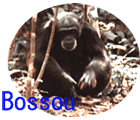|
TOP
-------Wild-------
Habitat
Research
site
--Bossou--
Geo.
Bossou
Research
Team
Chimp.
Beh.
Nimba/Diecke
Field
Info
News
References
Name
of Chimps(PDF)
Links |
ADJACENT COMMUNITIES OF
CHIMPANZEES
Members of the Bossou research team have also been carrying out
surveys and studies of neighboring chimpanzee populations in Séringbara
and Yéalé in the Nimba Mountains and Yossono and Nonah,
in the Diécké Reserve.
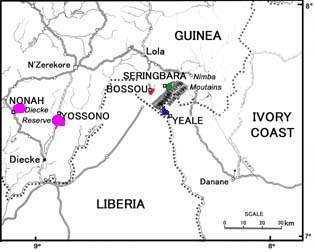
The Nimba Mountains
The Nimba Mountains are located directly to the southeast of Bossou.
Nimba is situated 230 km northwest of the Tai Forest, where a
community of chimpanzees has been intensively studied since 1976
(Boesch, 1978). 
The Nimba Mountains were established as a nature reserve in 1943 in
Côte d'Ivoire, and in 1944 in Guinea. The nature reserve on the
Côte d'Ivoire side is a "foret classee", under
national ownership. The Guinea portion of the massif was accepted as a
biosphere reserve in 1980, consisting of 17,130 ha. Both reserves now
form a World Heritage Site, gazetted in 1981 for Guinea and in 1982
for Côte d'Ivoire.
The reserve extends over 220 sq. km and its highest peak, Mont
Richard Molard, is at 1752 m. The reserve on the Guinean side extends
over 13,000 ha and 5,000 ha on the Côte d'Ivoire side. The Nimba
Mountains are cut up by deep, richly forested valleys. There is great
topographical diversity, with valleys, plateaux, rounded hilltops,
rocky peaks, abrupt cliffs and bare granite blocks, and the whole area
constitutes a vast water catchment.
The Nimba Mountains have attracted the interest of scientists,
including geographers, geologists, soil experts, botanists, zoologists
and other specialists ever since the late 1930's (Kortlandt, 1986).
Botanical, zoological and geological inventories have consequently
been completed. The single most important work, a comprehensive and
extensive record of the flora of the Nimba Mountains, was produced by
Adam (1971-1983). |
|
Thus, there are three vegetation types which dominate the Nimba
mountains (WCMC, 1982):
1) High altitude grassland near the summit and woody plants on the
slopes, which are absent from the ridges; interspersed with patches of
montane forest, dominated by Myrtaceae species, and Marantaceae and
Zingiberaceae growth.
2) Savanna varying depending on the hardness and geological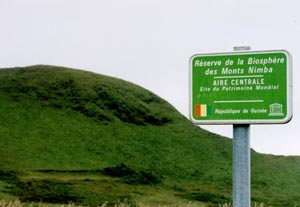 structure of the soil and supporting numerous herbaceous plant
communities. The savanna is broken by gallery forests between 1,000m
and 1,600m. Parinari excelsa is a dominant species above
1,000m, where there is also an abundance of epiphytes.
structure of the soil and supporting numerous herbaceous plant
communities. The savanna is broken by gallery forests between 1,000m
and 1,600m. Parinari excelsa is a dominant species above
1,000m, where there is also an abundance of epiphytes.
3) Predominantly primary forest, located mainly on the foothills and
in the valleys, with dominant species including Triplochiton
scleroxelon, Chlorophora regia, Morus mesozygia,
Terminalia ivorensis, Lophira procera, Tarrieta
utilis, Chrysophyllum gambia (perpulchrum), and
Mapania spp. Drier mid-altitude forests with trees such as
Triplochiton scleroxelon, Piptadeniastrum africanum,
and Parkia bicolor are also found most commonly on the steeper
slopes of the massif on the Côte d'Ivoire side. More than 2,000
plant species have been described from the Nimba region, and about 16
are thought to be endemic (Adam, 1971-1983). The area has, as a
result, been identified as a center of plant diversity under the
IUCN-WWF Plants Conservation Program (IUCN/WWF, 1988).
The Governments of both Guinea and Côte d'Ivoire have also
organized since 1982 various missions and training conferences
together with UNESCO in order to redefine the problems of ecosystem
protection in the Nimba Mountain region (Pascual et al, 1988; Pascual
et al, 1989). All these publications and missions have enormously
contributed to scientific knowledge of various species of fauna
(Lamotte, 1982) and flora (Fournier, 1987; Schnell, 1987), and soils
found in the Nimba Massif. Since 2001, Fauna and Flora International
has also supported Tripartite Meetings between Liberia, Guinea and Côte
d'Ivoire in order to promote a more efficient and harmonious
management of the entire Nimba Mountains' region. |
|
Séringbara, Guinea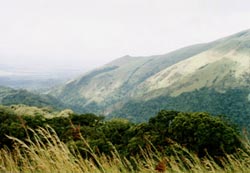
The village of Séringbara (latitude 7°37'81 N and
longitude 8°27'73 W) is located at the foot of the Nimba
Mountains on the Guinean side, only 6 km to the southeast of Bossou.
Two very basic campsites (the Gahtoy camp: latitude 7°39'57 N and
longitude 8°25'08 W, and the Kiepa camp), which serve as our
bases, were established within the reserve.
Shimada (2000) had previously provided confirmation of the
occurrence of chimpanzees in the region, after two short surveys of
the area in 1999, during which nests and feeding remains of
chimpanzees were found in the forest beside the village. Indeed, over
70 nests were then found in the area. In addition, vocalizations of
chimpanzees were frequently heard. This strongly suggested the
presence of a resident group at this site. This was further confirmed
during Matsuzawa's and colleagues' visit to the Séringbara
forest in January and February 2000 and Humle visits to this site
between June and September 2000 and June and September 2001, during
which they recorded further evidence of chimpanzees in the area,
including nests, feeding remains and indications of tool use (Humle
and Matsuzawa, 2001).
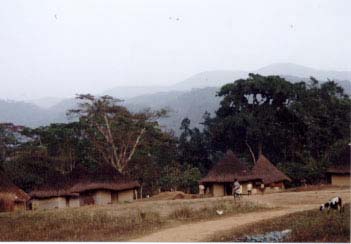 During
Humle's surveys of the site, minimum nesting group size was one and
maximum was 21, therefore if infants are included, group size must be
at least 30 individuals, assuming that at least nine adults females
were present and carrying infants. Perhaps one or two more chimpanzee
groups reside in the forest above the Séringbara village on the
mountain slopes, but only further research will confirm exact group
numbers and size. During
Humle's surveys of the site, minimum nesting group size was one and
maximum was 21, therefore if infants are included, group size must be
at least 30 individuals, assuming that at least nine adults females
were present and carrying infants. Perhaps one or two more chimpanzee
groups reside in the forest above the Séringbara village on the
mountain slopes, but only further research will confirm exact group
numbers and size.
There is no immediate threat to chimpanzees in this region, although
some poaching is still going on in the reserve but not aimed at
chimpanzees. Poaching incidences have reduced in frequency over the
last three years. Fires in the dry season may be affecting the
distribution of the chimpanzees but their influence has not yet been
established. Local people (Manon) in the Séringbara and Bossou
area consider the chimpanzee as the reincarnation of their ancestors
and therefore the chimpanzee in this region benefit from some
protection by indigenous people.
Yéalé, Ivory Coast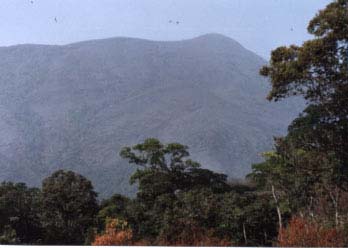
The village of Yéalé (7°32' N and 8°25' W) is
located 12 km, southeast of Bossou, on the other side of the Nimba
Mountains in Côte d'Ivoire. Matsuzawa and Yamakoshi established
this study site in 1993. Since 1993, a plan of habituation of the
chimpanzees in that area has been in progress, in collaboration with a
local agent of the "Centre des Eaux et Forêts" of
Danane. Preliminary surveys, carried out in the region, and
information from local people reveal that maybe three groups of
chimpanzees reside in the area, each one adjacent to one of three
major rivers found in the Reserve - the Nuon, the Yan and the Toua.
Humle has been continuing more intensive research at this site since
1999. A main campsite has been established within the reserve (Yanleu
Camp, 7°33' N and 8°28' W), three and half hours walk from
the village.
Goera (Gouela), Côte d'Ivoire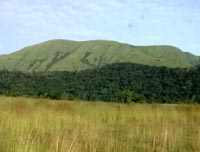
The Goera (Gouela) site (7°37'N and 8°22'W) is located
15km, southeast of Bossou, on the other side of the Nimba Mountains
near the border with Côte d'Ivoire. Sugiyama saw chimpanzees in
Goera and studied their nests and confirmed presence of ant-dipping in
1991 (Sugiyama et al., 1995). In 1999, Shimada surveyed this area
again and further confirmed chimpanzee presence (Shimada, 2000).
Traces of human activity and snares in the forest and the cautious
behavior of the chimpanzees suggest presence of poaching at this site.
Diécké, Guinea
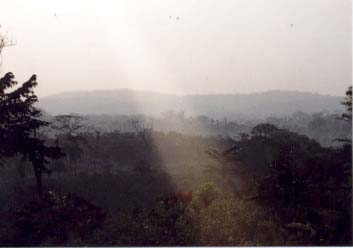 The
Diécké forest or "Forêt Classée de Diécké"
is located about 50 km to the west of Bossou. It is a reserve
extending over 700 sq. km in area, stretching about 35 km from north
to south and 35 km from east to west. The forest is under the control
of the "Centre Forestier" of N'Zérékoré.
The two study sites, which we have surveyed thus far, are located
beside two villages: Yossono (west of the reserve, 7°38' N and 8°30'
W) and Nonah (east of the reserve (7°33' N and 9°05' W)).
The explored sites consist primarily of primary forest covering small
hills, of which the highest peak is at 589 m above sea level
(Matsuzawa et al., 1999). It still remains undetermined as to how many
chimpanzees inhabit this reserve and how many communities pervade in
the area. But some preliminary behavioral data have emerged,
especially concerning tool-use at those sites (cf. Humle and
Matsuzawa, 2001). There were recent reports of hunting of chimpanzees
in the Yossono area dating back to July 2001, while hunting pressure
at Nonah does not appear to be as high. But hunting seems to be a huge
problem within this Reserve and may pose a considerable threat to the
chimpanzee populations living in that region. The
Diécké forest or "Forêt Classée de Diécké"
is located about 50 km to the west of Bossou. It is a reserve
extending over 700 sq. km in area, stretching about 35 km from north
to south and 35 km from east to west. The forest is under the control
of the "Centre Forestier" of N'Zérékoré.
The two study sites, which we have surveyed thus far, are located
beside two villages: Yossono (west of the reserve, 7°38' N and 8°30'
W) and Nonah (east of the reserve (7°33' N and 9°05' W)).
The explored sites consist primarily of primary forest covering small
hills, of which the highest peak is at 589 m above sea level
(Matsuzawa et al., 1999). It still remains undetermined as to how many
chimpanzees inhabit this reserve and how many communities pervade in
the area. But some preliminary behavioral data have emerged,
especially concerning tool-use at those sites (cf. Humle and
Matsuzawa, 2001). There were recent reports of hunting of chimpanzees
in the Yossono area dating back to July 2001, while hunting pressure
at Nonah does not appear to be as high. But hunting seems to be a huge
problem within this Reserve and may pose a considerable threat to the
chimpanzee populations living in that region. |
